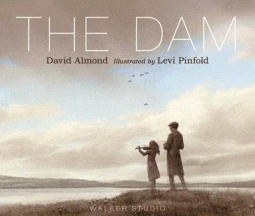
The Dam
The Dam
David Almond
Levi Pinfold
Walker Studio, 2018
32pp., hbk., RRP $A24.99
9781406304879
It looks like death will come to this valley as the dam is almost completed, and when it is and the waters rise, so much will be washed away, drowned and never seen again. In tribute to all that have gone and for all that are still to come, the musician sings and his daughter plays her violin as they wander through the empty houses that were once homes. But even though the physical things may be gone or going, the music plays on, locked in the memories as new opportunities await.
Forty years ago when a great dam was built by the Kielder Water in Northumberland, UK, the valley below slowly filled with water. But just before this, when the villagers had been moved out, two musicians went back to the abandoned valley. They tore down the boards over the houses, stepped inside and started to play – for this would be the last time that music would be heard in this place. But while much of the natural landscape was lost, a new one was created, one which brought new activities and adventures and allowed for new memories to be created.
While this is the story of a dam in the UK, it could be the story of places in Australia like Adaminaby, moved in the 50s to allow for the creation of Lake Eucumbene, nine times larger than Sydney Harbour and part of the might Snowy Hydro scheme that changed Australia forever. Yes the valley was drowned, and as droughts wrack this country, sometimes, as now, remnants of what was lost rise from the deep, but in its place is a haven for fishers, boaters and artists, and the influx of European refugees who came to help build it changed the shape of Australia forever.
It could be the story of parts of the South Island of New Zealand as dams like Benmore and Aviemore reshaped that landscape as the need for electricity grew; parts of Tasmania where building dams on Lake Pedder in the 60s and the proposed damming the Gordon below the Franklin River in the 70s shone the brightest spotlight on the environment and its conservation that this country had seen.
It could even be the story of those living near Badgery’s Creek where Sydney’s new airport is at last being constructed after 50 years of talk. It could be the story of 1000 places where human needs have outweighed those of Mother Nature and “progress” moves inexorably onwards and outwards.
But this is not a morbid book, despite its dramatic, monochromatic sombre palette, vignettes of things lost like fleeting memories and the haunting text which is like music itself. While it is a memorial to those who have gone before it is also a promise that there will be new life, new different memories waiting to be made and celebrated just as the change in colours and mood of the illustrations indicate.
Change throughout our lives in inevitable – some visible and dramatic, others not-so and more subtle – but each alters the path that we have planned or dreamed of. While this book might be overtly about a true story of the Northumberland wilds, it is a conversation starter for all those who are facing life-changing circumstances, physical or emotional. The musician and his daughter chose to remember through a musical tribute but were also ready to embrace the new landscape, illustrating that it is how we deal with and embrace that over which we have no control that shapes us. “That which doesn’t kill us, only makes us stronger” has never been more apt.